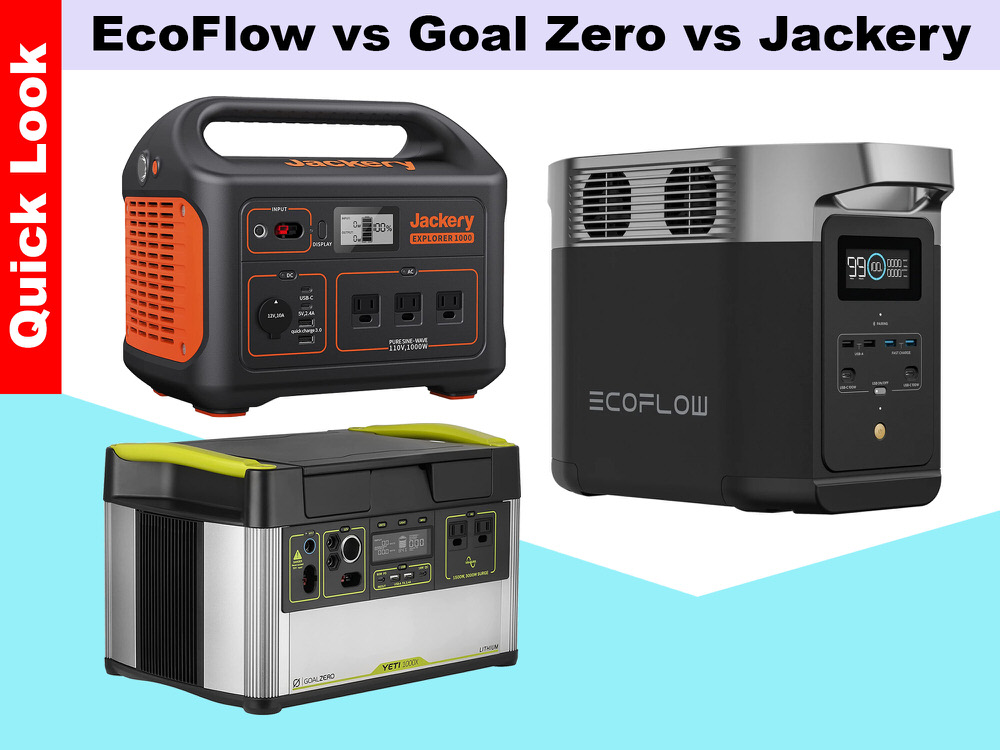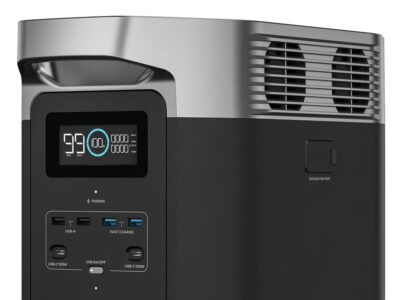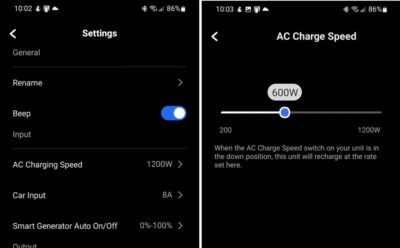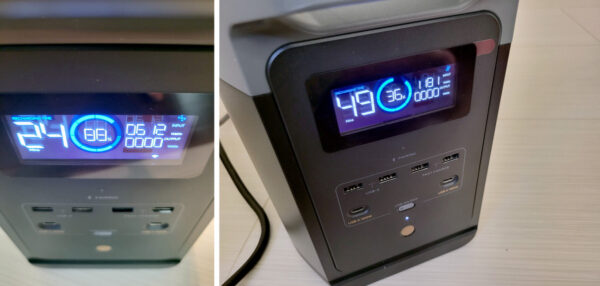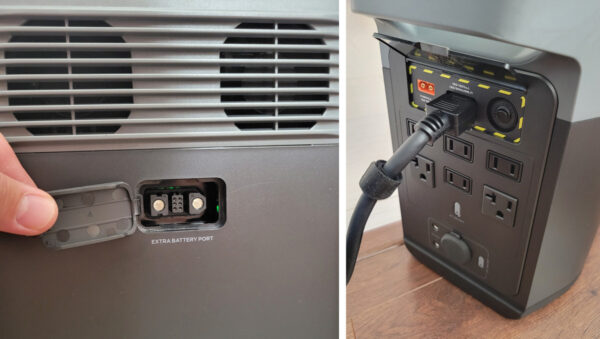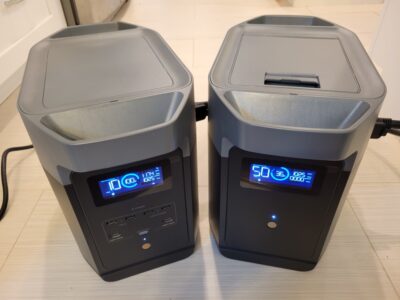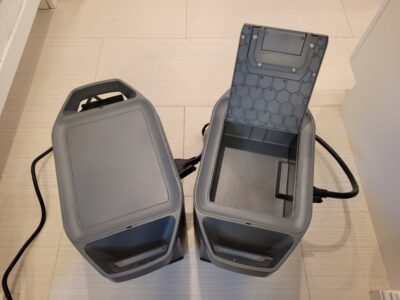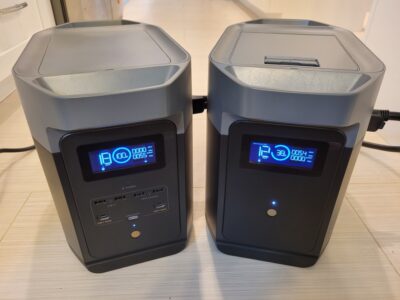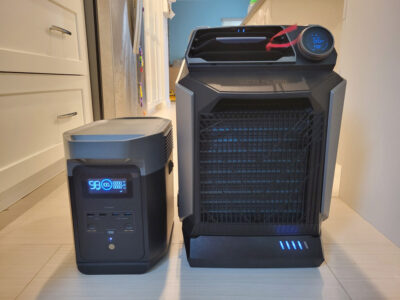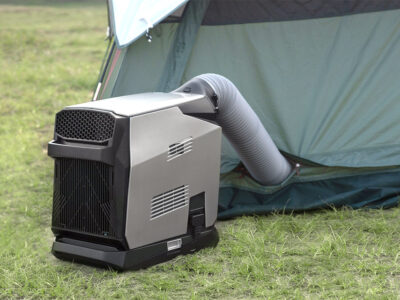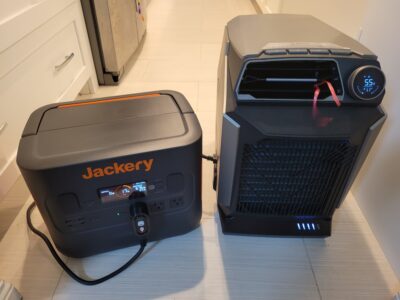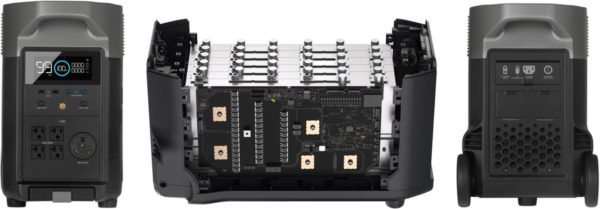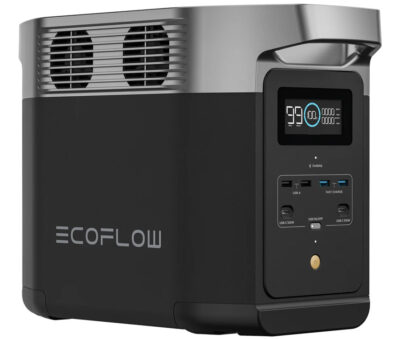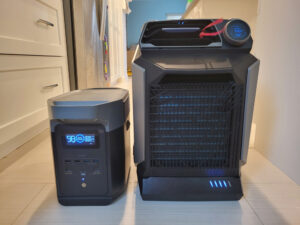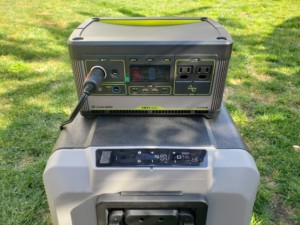Contents
Delta 2 Announcement
This article is a quick look at the differences between the EcoFlow Delta 2, Goal Zero Yeti 1000X, Yeti 1000 Core, and the Jackery Explorer 1000.
A more detailed review will be forthcoming.
In A Nutshell
EcoFlow announced the Delta 2 power station at IFA Berlin 2022 with the tagline of: “Not Just a Battery.” It was available for purchase on September 16, 2022. After their excellent Delta Pro we reviewed not too long ago for our vacation home, we were very intrigued by what this new product could do, and how it would compare against Goal Zero and Jackery.
The Delta 2’s 1,024Wh battery capacity — how long something can run for — and $999 price point puts it right in direct competition with the identically priced Goal Zero Yeti 1000x and Yeti 1000 Core, Jackery Explorer 1000, and its own predecessor, the EcoFlow Delta 1000 — but with one major change. Instead of using Nickel Manganese Cobalt (NMC), the Delta 2 now uses Lithium Iron Phosphate (LiFePO4) like its more powerful Delta Pro sibling. There are significant differences between both Lithium-ion (Li-ion) battery chemistries that I will detail later.
How much energy a battery can store is measured in Wh (Watt-hours), and how much power is used or produced in W (Watts).
Goal Zero launched the Yeti 1000 Core power station on July 16, 2021, five weeks after the flagship Yeti 1000x was available for purchase, and the Delta 2 packs more powerful features with its announcement a year later:
- LiFePO4 battery chemistry (Pros and Cons to that over NMC)
- 1,200W AC charging input
- Rapid-charging from 0 to 80% in an unheard of 50 minutes — a claim I personally verified to be accurate
- Test #2: 36% to 88% in 32 minutes (4:34pm to 5:06pm)
- Fans were VERY loud during that time and significantly got more quiet around the 90% charged mark
- If fan noise is important to you (ie. because of tight sleeping quarters), be mindful of that. On the other hand, it would only take 50 minutes to go from 0 to 80% charge. A workaround may be to charge before going to sleep or to lower the maximum charging speed to 600W or less
- Rapid-charging from 0 to 80% in an unheard of 50 minutes — a claim I personally verified to be accurate
Fan too loud? Charge before going to sleep or lower maximum charging speed to 600W or less from the EcoFlow smartphone app.
- 500W solar charging input (11-60V @ 15A)
- Whopping 15 outlets
- AC output at a Continuous 1,800W and Peak of 2,700W
- X-Boost output at 2,200W
- USB-C at 100W
- Mobile app control via WiFi or Bluetooth – See YouTube Video
- Near-instant auto-switching between AC and battery power
- Makes it suitable for use as a Standby Power Supply (SPS) during a blackout
- Expansion options
- Battery capacity expansion to a total of 2,048Wh or 3,040Wh with the Delta 2 Extra Battery (+1,024Wh) or Delta Max Extra Battery (+2,016Wh), respectively
- Only the Goal Zero Yeti 1000x (983Wh) has expansion capabilities in this 1,000Wh-battery roundup to a total of 5,783Wh (938Wh + four 1,200Wh Yeti Tanks)
- Connectivity with solar panels, the EcoFlow Wave portable air conditioner, and EcoFlow Smart Generator
- Battery capacity expansion to a total of 2,048Wh or 3,040Wh with the Delta 2 Extra Battery (+1,024Wh) or Delta Max Extra Battery (+2,016Wh), respectively
- 5-year warranty
EcoFlow, Goal Zero, and Jackery power stations can be used while simultaneously charging themselves.
Sweet Spot: The 1000Wh battery capacity hits the sweet spot for many consumers, including this author, who are looking for the right balance of power and portability. But when it comes to home integration, the more Watt-hours a battery ecosystem offers, the longer one can power a home for during a blackout.
Extra Battery: Delta 2 EB
I paired the Delta 2 Extra Battery (EB) with the Delta 2 power station for a combined battery capacity of 2,048Wh. I was happy to see that chaining the EB to the Delta 2 and charging it from the AC wall produced about 1,100W of input to the EB. This would have fully charged the EB in about 60 minutes. Without the AC input, the EB sipped only about 54W directly from the Delta 2 and would have taken 19 hours to fully charge an empty EB from 0%.
When plugged in to the AC wall, the Delta 2’s fans kicked in loud like a jet — the same as when it was charging at 1,100 – 1,200W without the EB attached. Once the Extra Battery was at around 90%, charging dropped to roughly 700W, and the Delta 2’s fans lowered manageably quieter. If the loud fan bothers you, charge before going to sleep or lower maximum charging speed to 600W or less from the EcoFlow smartphone app.
Note: Delta 2 Extra Battery cannot be independently charged. It must be connected to the Delta 2.
Extra Battery or Two Delta 2’s?
Should you get a Delta 2 with Extra Battery or spend a few hundred dollars more and get two Delta 2’s instead? If you go for the latter, that will give you several benefits, including the option to have a second, working power station if one fails, additional outlets, and independent use and charging of both batteries. However, the biggest disadvantage would be the need to manually swap out the depleted Delta 2 with the other one as both cannot be linked to one another without power loss from the AC Inverter. In that configuration, they will act like (and actually are) two standalone batteries (of 1,024Wh each) instead of one cohesive unit that can provide uninterrupted power at double the capacity (1,024Wh + 1,024Wh = 2,048Wh).
Portable Air Conditioner
The EcoFlow Wave is a portable air conditioner that accepts both AC and DC input. The company, of course, recommends using its own Delta power stations for better efficiency and longer runtime because they can draw directly from DC power. In a pinch, any battery or generator capable of providing the Wave-required input wattage could be used, but keep in mind that AC power loses some energy due to conversion to DC.
Battery Technology
Li-ion: LiFePO4 vs NMC
There had been a lot of debate over whether Nickel Manganese Cobalt (NMC) or Lithium Iron Phosphate (LiFePO4) was better. Both are Lithium-ion batteries. Goal Zero, Jackery, and most of today’s power station manufacturers use NMC, but why do EcoFlow and Bluetti use LiFePO4 when they are bulkier and heavier? There are important distinctions, but the best battery is the one that meets all or most of your unique needs.
Charge Cycles
One of the most significant differences — and buying factors — is the charge cycle count for both battery chemistries. It measures how long the battery can be used for before it must be replaced or thrown away. LiFePO4’s count is as high as 4,000 cycles (as of 2023) whereas NMC is 500+. However, both have a useful life that can range between 3,000 – 5,000 cycles (even as much as 7,000 with proper care). But how does the count determine longevity?
Let’s look at Li-ion NMC as an example. It loses about 20-25% of total capacity after every 500 charge cycle. That means after the first 500 cycles, the battery drops 20% from when it was new, then another 20% after the next 500 cycles, and 20% again after that one. It would take roughly 1,500 charging cycles to have the battery last only half as long as when it was brand-new. Thus, it should be usable for 2,000+ cycles or about 6-10 years. Li-ion LiFePO4 can last longer.
CAUTION: Lithium-ion (LiFePO4 and NMC) batteries do NOT like to remain discharged at 0% for prolonged periods of time. If you let your battery stay at 0% for too long, you may not be able to charge it again without specialized equipment. Keep them at between 20-80% while in storage to maximize their lifetime.
LiFePO4 Advantages
- Safer, less volatile, and thus cheaper to manufacture
- Higher charge cycle: 1500-2000 (10+ years). NMC: 500+ (6-10 years)
- Usable in more extreme temperatures (-4F/-20C to 176F/80C). NMC: only 140F/60C max
- Holds 350-day charge. NMC: 300
NMC Advantages
- Smaller and lighter. Allows for more portable products
- Faster charging
Comparison Summary
Here is a summary of differences between the various 1000Wh power stations from Goal Zero, EcoFlow, and Jackery Explorer. The Yeti 1000 Lithium is the oldest of the Yeti series.
| Product | Battery Capacity | AC Inverter (Continuous) | AC Inverter (Surge) | Max Input | MSRP | Expandable | Charge Controller | WiFi, BT | Battery Supplier | Weight | Dimensions (inches) |
|---|---|---|---|---|---|---|---|---|---|---|---|
| EcoFlow Delta 2 | 1,024Wh LiFePO4 | 1,800W | 2,700W | 1,200W | $999 | Yes. Extra Battery 1, 2 | MPPT | Yes | EcoFlow | 27 lbs | 15.7 x 8.3 x 11 |
| EcoFlow Delta 1000 | 1,008Wh NCM | 1,600W | 3,100W | 1,000W | $799 | No | MPPT | No | EcoFlow | 30.9 lbs | 15.7 x 8.3 x 10.6 |
| Jackery Explorer 1000 | 1,002Wh NCM | 1,000W | 2,000W | 200W | $999 | No | MPPT | No | LG or BAK | 22 lbs | 13.1 x 9.2 x 11.1 |
| Jackery Explorer 1000 Pro | 1,002Wh NCM | 1,000W | 2,000W | 800W | $1,099 | No | MPPT | No | LG or BAK | 25.4 lbs | 13.4 x 10.3 x 10.1 |
| Goal Zero Yeti 1000c | 983Wh NCM | 1,200W | 2,400W | 300W | $999 | No | MPPT | No | LG | 31.7 lbs | 15.3 x 10.2 x 9.9 |
| Goal Zero Yeti 1000x | 983Wh NCM | 1,500W | 3,000W | 600W | $1,299 | Yes. Yeti Link | MPPT | No | LG | 31.7 lbs | 15.3 x 10.2 x 9.9 |
| Goal Zero Yeti 1000 Lithium | 1,045Wh NCM | 1,500W | 3,000W | 360W | $1,199 | Yes. Yeti Link, MPPT | PWM | No | LG | 40 lbs | 15.3 x 10.1 x 9.3 |
Final Thoughts
EcoFlow thoroughly impressed us with their Delta Pro power station and quickly added the company to our list of recommended battery providers. Their newest Delta 2, now a LiFePO4 product, further surprised us with 1,200W rapid-charging that took the battery from 0 to 80% in a whopping 50 minutes! Had we not seen that in person, we would have dismissed it as a marketing gimmick, but we were proven wrong. Add to that the ability to have its capacity and features expanded with additional products, and the Delta 2 makes for a VERY compelling choice against Goal Zero’s own Yeti 1000x that is starting to show its age. Jackery, on the other hand, is extremely difficult to recommend against the Delta 2, except that they have excellent customer service and consumer-friendly policies.
Fan noise at the 1,200W rapid charging speed was cited as a primary concern for many, this author included, and one could either charge before going to sleep (up to 50-60 mins) or set the maximum input to 600W or less from the EcoFlow smartphone app so the fans would not go at full speed in normal, ambient temperatures.
Stay tuned for our full review later this year!
Where To Buy
- EcoFlow
- Power Station: Delta 2 / Delta 1000
- Extra Battery: Delta 2 (+1,024Wh) / Delta Max (+2,016Wh)
- Smart Generator (Gasoline)
Related Posts
- Power Generators: Gas vs Propane vs Battery Station (and Solar)
- Ultimate Reference: Power Station Comparison
- Quick Look
- Announcements
- Reviews
- EcoFlow Delta Pro LiFePO4
- EcoFlow 220W Bifacial Solar Panel
- Goal Zero vs Jackery: Yeti 1000 Core vs 1000X vs Explorer 1000
- Goal Zero Yeti 1500x / Yeti 1000x / Yeti 1000 Core / Yeti 500x
- Jackery Explorer 2000 Pro / Explorer 1000 / Explorer 300
- Bluetti EB70S LiFePO4
- BigBlue Cellpowa500 LiFePO4
- Rockpals 500W / nrgGo 400
- EcoFlow Wave Portable Air Conditioner
Other Useful Topics
Power Station Comparison
Check it out!
Ultimate Reference: Power Station Comparison – We summarized the specifications of many of the power stations we had come across or reviewed all in one place.
Gas/Propane Generators vs Battery Power Stations
In July 2020, I wrote about this topic after many asked what their differences were. In short, gas/propane generators can run virtually forever but are loud, dirty, and potentially quite dangerous. Battery power stations, on the other hand, are more portable, silent, less volatile, and can be operated indoor, but depend on external power (like solar) to recharge. Where gas/propane are used to GENERATE electricity, batteries STORE them for later use. Personally, I am a fan of the latter because they are so easy to carry around and are safer to use.
Who is EcoFlow (EF)?
EcoFlow was formed in 2017, ten years after Goal Zero had its start. Four years later saw the launch of the Delta Pro series in 2021 that garnered so much widespread attention, it earned one of Time Magazine’s “Best Inventions of 2021” under the “Sustainability” category.
A friend of mine once said that Goal Zero is “the best of the best” because of one simple reason: their vast ecosystem. I did not understand at the time what he meant, but as I learned more about the Yeti 1500x, my eyes were opened. Then EcoFlow came along with the Delta Pro that not only matched, but managed to surpass Goal Zero in many ways with its own collection of products.
Battery Technology and Safety
Goal Zero debuted with Lead-Acid batteries that were bulky and heavy. Today’s devices use Lithium-ion — commonly Nickel Manganese Cobalt (NCM) or Lithium Iron Phosphate (LiFePO4 / LFP) chemistries — for more power in a smaller, lighter package. NMC, however, is more volatile than LiFePO4 and becomes riskier as more cells are packed together. Goal Zero and Jackery used NMC for some time whereas EcoFlow and Bluetti use LiFePO4. Jackery launched its first LiFePO4 model in mid-June 2023 and Goal Zero in October that year.
- How much energy a battery can store is measured in Wh (Watt-hours), and how much power is used or produced in W (Watts)
- The higher the Watt-hour (Wh) capacity rating, the more dangerous the battery could become if not handled right
The quality of the battery cells and the BMS (Battery Management System) are crucial for safety.
Cell Manufacturers
Battery cells made by LG and Sony are among the best in the hobbyist world as are Sanyo/Panasonic and Samsung. Goal Zero uses LG. Jackery also uses LG or BAK (a leading Chinese brand). EcoFlow makes its own. During my years of research, I found that use of lower-quality batteries could pose a serious risk to life and property and should become a crucial part in deciding what to buy.
Safety
The second part in a battery’s safe operation depends heavily on the design and BMS (Battery Management System). Some BMS manufacturers, unfortunately, overstate their capabilities that could lead to catastrophic failure.
- Design should allow for proper, thermal cooling, use quality components, and obtain proper certifications
- Batteries made by known manufacturers are less likely to fail
- BMS should sufficiently restrict the battery from going past its capabilities

